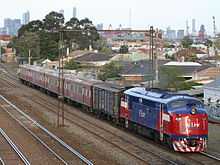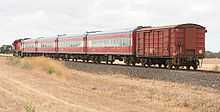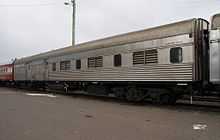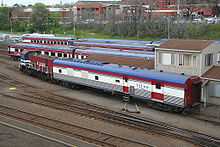Victorian Railways power vans
| Power Vans | |
|---|---|
| Manufacturer | Victorian Railways |
| Built at | Newport Workshops, others |
| Operator | VR, SAR, NSWR and successors |
| Specifications | |
| Power supply | Diesel generators |
| Track gauge | 5 ft 3 in (1,600 mm) |
The Victorian Railways of Australia and successors have utilised a number of different types of railway carriages and wagons for the supply of head end power to passenger trains on the Victorian railway network.
When train travellers around the world began to enjoy such comforts as lighting, and heating and cooling, the Victorian Railways initially employed axle mounted generators, then progressed to more reliable head-end power (HEP) as a source for this equipment. In more recent times, vans have been specially built for the purpose of supplying HEP, or special generators are fitted to locomotives (the N and P classes)
Current V/Line
PH Vans

By the mid-1980s, passenger trains within Victoria almost always required head-end power (HEP), as the wooden cars were phased out. While a number of trains had self-contained generator supplies, the majority required HEP from outside sources. The N and P class locomotives were fitted with HEP generators, but if another locomotive were to haul the train, there would be no power supply for the carriages.
To this end, three freight vans were fitted with generator sets and cabling in 1984. The corrugated roofs were replaced with sheet metal. The vans were coded PH and numbered 451, 452 and 453. They were converted from VLPY freight wagons 139, 140 and 142 respectively, and appeared in a grey livery. These vans are all in service on the broad gauge today, in a plain, dark blue livery. In late 2009/early 2010, PH 454 was created from DN 404, and painted grey.
D, DT & DN Vans

While not HEP vans, these wagons are worthy of mention. The D vans were converted from VBPY, VBAX or VBAY vans in 1983. D vans were added to locomotive-hauled V/Line services when extra luggage space was required.
When HEP cabling between a loco and carriage set was introduced, the D vans were modified so as to allow the locomotive's HEP unit to power the carriages without requiring removal of the van. Modified vans were re-classified DT.
DN vans are similar to D vans, except that when they were released following conversion from VBPYs in 1984, they were already fitted with through cabling, so do not have a "T" on their number boards.
V/Line has three DN vans. DN 401 and 402 have not been seen for some time, although there is no indication that they have been scrapped. DN 403 is stored at Newport Workshops, still wearing the original "V/LINE" orange livery, implying that it has not been used since 1995. Until recently, DN 403 was kept near DN 404 until it (404) was converted to PH454.
The remainder of the DT vans are in service in a plain red livery or in the former West Coast Railway livery.
Victorian & New South Wales Joint Stock
PHN vans

The PHN class were Standard Gauge Joint Stock owned by New South Wales and Victoria. They were steel fluted sided vans, and ran between Sydney and Melbourne, on trains such as the Southern Aurora. Six were built from 1961, three for the Southern Aurora, and three for the Spirit of Progress. The former three were numbered PHN 2361 - PHN 2363, while the latter three were PHN 2369 - PHN 2371.
PHN 2370, destroyed in the Violet Town collision in 1969, was replaced by PHN 2381 built in 1970. In 1981, PHN 2362 and 2363 were renumbered to 2862 and 2863 respectively.
Victorian & South Australian Joint Stock
PCO/PCJ vans

By the late-1960s, The Overland, which ran between Melbourne and Adelaide, required head end power for air conditioning and lighting. Prior to this time, all electrical power had been supplied by axle-driven generators. As a result, the two railways between them built four PCO vans, numbered 1 - 4, in 1970. They were Joint Stock vehicles owned and maintained jointly by the VR and South Australian Railways, and their later, respective incarnations of VicRail and V/Line (VR), and Australian National (SAR). Each had two 162.5 kilowatts (217.9 hp) diesel generators and could carry 10 tonnes (9.8 long tons; 11 short tons) of luggage. In 1990 the V/Line N class locomotives, which had their own head end power units, took over hauling the Overland and the PCO vans were put into storage.
In 1992, V/Line and Australian National took full ownership of two vans each. V/Line took PCOs 1 and 3, which it renumbered PCJ 491 and 492 respectively, and AN took PCOs 2 and 4. PCO 2 remained in storage until was purchased by West Coast Railway in 1998. When West Coast Railway ceased operation in 2004 it was acquired by V/Line and in 2009 was refurbished and renumbered to PCJ 493.[1] A three PCJ vans were converted to standard gauge in 2011 for use on the V/Line Albury service. Australian National used PCO4 on the short-lived Explorer tour train in South Australia )|Great Southern Railway]] and converted to standard gauge for use again on the Overland. It was completely refurbished in 2007 with new diesel generator sets. These carriages are only used on the Albury line≤≥
Notes
- ↑ "Wongm's Rail Gallery - PCJ van transfer to and from Ballarat". wongm.railgeelong.com. September 15, 2009. Retrieved 2009-11-16.
References
- Peter J. Vincent: PHN - Joint Stock Power Van
- Peter J. Vincent: PH - Head End Power Van
- Peter J. Vincent: PCO/PCJ - Guard's Van with Head End Power Unit
- V/LineCars: D Vans - Luggage vans
- V/LineCars: D Van Image Gallery
| ||||||||||||||||||||||||||||||||||||||||||||||||||||||||||||||||||||||||||||||||||||||||||||||||||||||||||||||||||||||